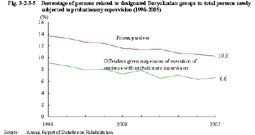| Previous Next Index Image Index Year Selection | |
|
|
3 Probation and parole supervision
Fig. 3-2-3-5 shows the percentage of probationers/parolees who are considered to have a connection with designated Boryokudan groups under the Anti-Boryokudan Act to all probationers/parolees at the time of admission to supervision over the last 10 years.
Fig. 3-2-3-5 Percentage of persons related to designated Boryokudan groups to total persons newly subjected to probationary supervision (1996-2005) The categorized treatment system (see Part 2, Chapter 5, Section 2, 2 (2)) regards the following probationers/parolees as "persons related to Boryokudan groups": (a) those who are leaders, members, and quasi-members of Boryokudan groups; or (b) those who previously fell under (a) above and are not considered to have left the groups completely. For those probationers/parolees in this category, in cooperation with the police and prefectural centers for promoting the violent-expulsion movement, efforts are made to understand the reality of their daily lives and provide them with intensive guidance and support in order to encourage them to leave their crime groups and establish stable lives with decent jobs. |
